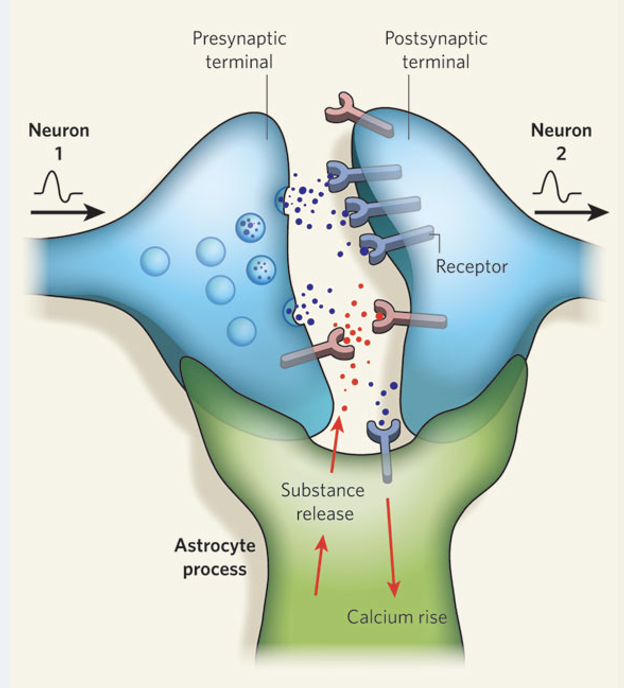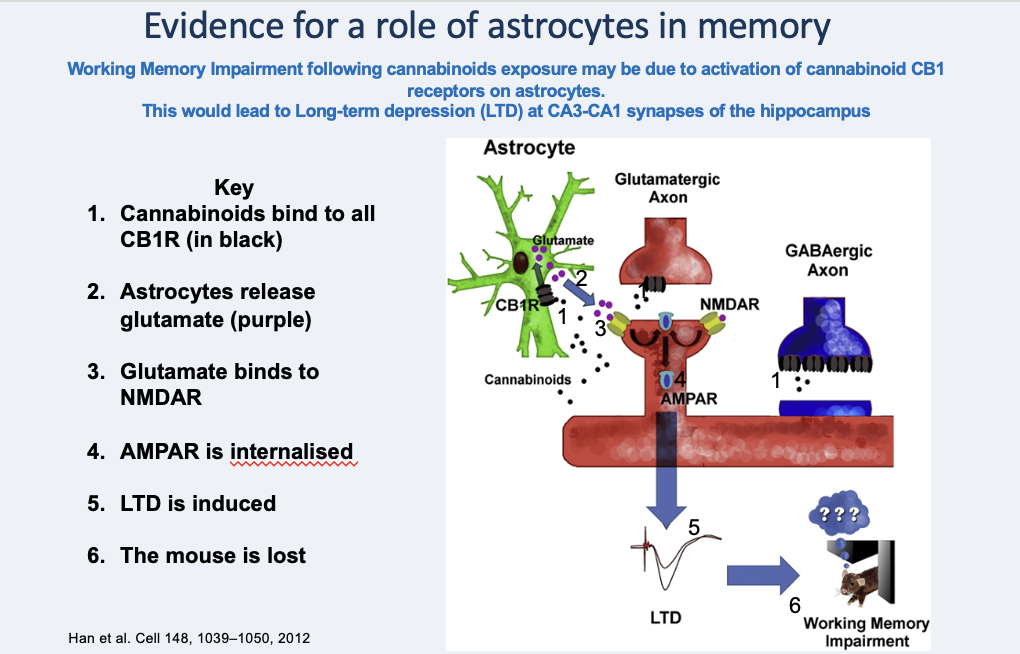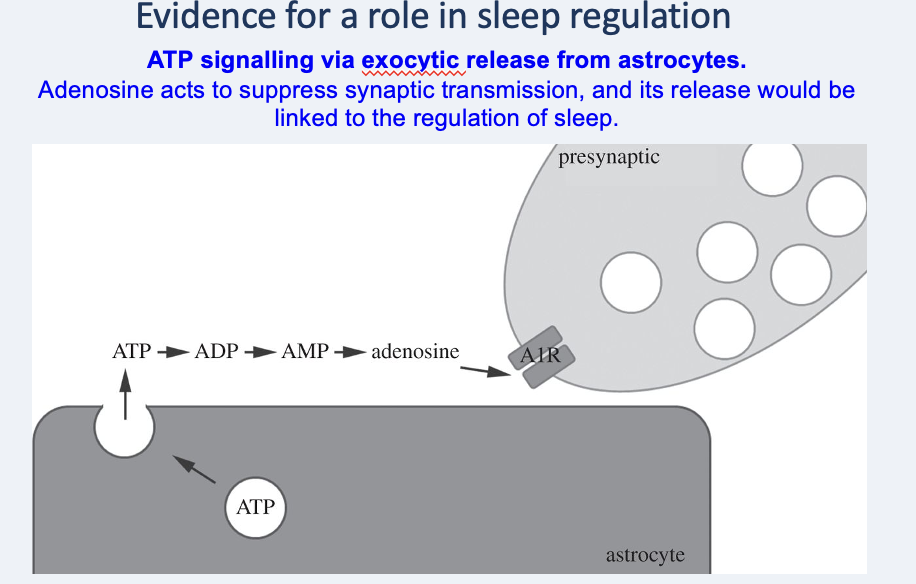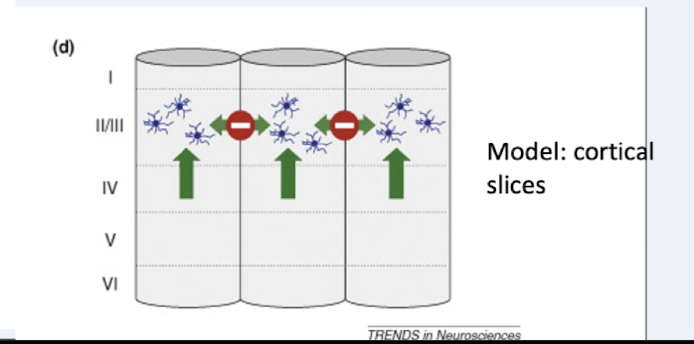lecture 12: astrocyte pathophysiology
1/33
There's no tags or description
Looks like no tags are added yet.
Name | Mastery | Learn | Test | Matching | Spaced |
|---|
No study sessions yet.
34 Terms
T/F: ~50% of cells in human brain are glial
true; astrocytes contribute to at least 1/3 of brain mass
what are the types of astrocytes, where are they, + what do they do (2)?
protoplasmic → grey matter (wrap synapses around neuronal cell bodies)
fibrous → white matter (wrap oligodendroglial cells + nodes of Ranvier)
what did a study by Han et al., find about astrocytes?
mice with transplanted human glial progenitor cells → gave rise to human astrocytes
these mice w/ human astrocytes performed better in learning + memory tasks as well as displayed improved LTP (strengthening of synaptic connections)
what are 3 main aspects of astrocyte involvement?
modulation of synaptic function → tripartite synapse
astrocyte networks
glymphatic systems
how can we visualise astrocytes?
staining for GFAP
T/F: we can stain all astrocytes with GFAP
false; it only stains a proportion of their larger processes.
what are 5 main proposed astroglial functions?
developmental
structural
metabolic
homeostatic
signalling (info-conveying, instructional)

T/F: all astrocytes perform the same functions
false; they are heterogenous in multiple aspects
morphology
membrane currents
expression of receptors (glutamate or other NTs)
expression of GLUTs
coupling of DJs
Ca2+ signalling
vol reg
what is the tripartite synapse?
a synapse composed of 3 elements; a presynaptic neuron (1), post-synaptic neuron (2), and astrocyte process on the two

what is the tripartite synapse hypothesis?
during synaptic activity, neurons release NTs + astros respond to these w Ca2+ elevations
in turn, this controls neuronal excitability AND synaptic transmission via this Ca2+ dependent release of gliotransmitters, including
GABA
glutamate
ATP
adenosine
D-serine
etc….
what led to this evidence for gliotransmission via astrocytes (2)?
astrocyte Ca2+ signalling in brain slices and in vivo experiments showed that astrocyte Ca2+ levels increased after
electric stim of schaffer collaterals in hippocampus (brain slices)
whisker stimulation in mice (in vivo)
this proved that astrocytes have cellular excitability
T/F: it has yet to be shown that although astrocytes have excitability, they do NOT integrate synaptic information
false; in hippocampus slices, a Ca2+ increase response triggered by Schaefer collateral stimulation was blocked by mGluR antagonists.
a lack of correspondence was seen b/w observed + expected responses which was indicative of synaptic integration
overall, what did the tripartite synapse show?
astrocytes have cellular excitability (respond w increase of Ca2+ to sensory stim)
astrocytes can discriminate activity of diff pathways (e.g., astros in CA1 of hippocampus did NOT respond to Glu after stim of laves, but did respond to Glu released by Schaeffer collateral)
Ca2+ signals show non-linear relationship w synaptic activity Or exogenous application of NTs
how can astrocyte modulation @ tripartite synapse influence memory?
through LTP
mice lacking CB1R (cannabinoid T1Rs) in astroglial cells OR glutamaterigc/GABAergic neurons were exposed to cannabinoids
these mice lacking astrocytic CB1R had functioning spatial working memory AND LTD was not induced
but memory impairment + LTD induction was seen in mice lacking CB1R in neurons
Since Han et al showed cannabinoids can exert their action on working memory also in absence of receptors on neurons, was concluded that astrocytes mediate their action.
if CB1R knocked out on GABAergic axon, working memory impairment + LTD still occurred so CB1 action was not at these sites
• however if KO on astro, neither occurred (so CB1 important R is on astro, and astros have a role in this working memory)

how can astrocyte modulation @ tripartite synapse influence sleep reg?
astrocytes can release gliotransmitters via (eg exocytosis). when ATP is released, astrocytes can mod the behaviour via A1Rs in sleep reg via our circadian clock by conversion of ATP → Adenosine

by which mechs can astros release NTs (6)?
swelling-induced opening of v-gated ion channels
reverse operation of EAATs
Ca2+ dependent exocytosis
cystine-glutamate exchanger
connexion hemichannels
P2X7 Receptor
how can astrocytes form networks with each other?
via formation of gap junctions to form gap junction channels (composed of connexins)
what properties do GJs in astrocyte display?
selective permeability
voltage-dependent
T/F: astrocytes can respond to the stimulation of adjacent functional networks
false; they communicate within barrels but not w astrocytes in surrounding barrels

how do astrocytes DIRECTLY regulate neuronal activity?
by supporting propagation of Ca2+ waves which can lead to signalling via connected astrocytic networks (GJs) → release of ‘gliotransmitters’ to cause release of NTs
how can astrocytes have a role in epilepsy?
by astrocytic network reg of neuronal activity via release of NT and/or K+ buffering; extracellular accumulation of K+ follloing repeated/prolonged activation of synapses can depolarise the neuron making them hyper excitable
what happens to astrocytes in injury/infection/diseased states?
they exhibit reactive astrogliosis, can respond to signals from a variety of sources, and can release a mix of neurotoxic/protective molecules.
chronić astrocyte reactivity can lead to…
loss of normal or gain of abnormal function → exacerbate disease state w dysfunctional reactivity to worsen disorder outcome
T/F: genetic mutations + polymorphisms can lead to cell-autonomous dysfunctions in astrocytes → nonreactive disease states
true
what does the dual role of homeostatic cascades expressed in astrocytes control?
physiological conditions
K+ buffering
reg + dist of H2O
control of extracellular [NTs]
pathological conditions
failure in H2O transport (brain oedema)
glutamate excitoxicity (several of NT transporters w Ca2+ dependent exocytosis)
inadequate K+ buffering (excitation)
release of ROS + pro-inflammatory factors
T/F: reactive astrogliosis (assoc. w neuroinflammation) is present in several neurodegenerative diseases
true
which main neurological conditions are astrocytes implicated in (3)?
alexander disease
alzheimer’s disease
epilepsy
explain the role of astrocytes in alexander disease
they are the primary cause; a genetic disorder of astrocytes (dominant, gain-of-function mutation in GFAP gene)
loss of fine processes
heterogeneous reactive phenotype
reduced levels of AQP channels
not coupled @ GJs + connexins are decreased
reduced buffering of glutamate + accumulation of GABA
lower levels of K+ channels
seizures
psychomotor disturbances
premature death
what is the proposed role of astrocytes in AD?
reactive astrogliosis around amyloid plaques OR diffuse amyloid deposits has been present but not clear if it precedes disease onset
also, atrophic changes in astroglia have been observed
potential EAAT2 decline w progression; excitotoxicity?)
what did Chun et al observe abt H2I2 mediated brain atrophy by induced astrocytosis?
showed importance of astrocytic reactivity on pathogenesis of AD using GiD model of reactive astrocytes
GiDm (mild astrocyte reactivity) vs GiDs (severe)
H2O2 originates from MOA-B in severe reactive astros → glial activation, tauopathy, brain atrophy, eventual death
H2O2 induced pathological features of AD in GiDs are consistent
H2O2 in severe but not mild reactive astrocytes is a key determinant of neurodegeneration in AD
what is proposed for astrocyte implications in the glymphatic system ?
regarding Aß clearance, in sporadic AD…
with ageing, lymphatic function is reduced
may be due to astros becoming reactive
accumulation of ß-amyloid may be due to impairment of glymphatic system
how can astrocytes contribute to seizure generation ?
• recurrent spontaneous seizures
◦ due to hyperexcitability + hypersynchrony of brain neurons
◦ do astros have a primary role in epileptogenesis and/or seizure generation?
‣ can disrupt K+ buffering
‣ can disrupt E supply --> neuron
a wide range of astro abnormalities could contribute to seizure generation
what are the main epilepsy-associated alterations of functional properties in astrocytes (3)?
K+ channel
AQP channel (important for iron balance)
Glutamate release + neuronal synchronisation
T/F: • astroglial Glutamine Synthase deficiency is sufficient to cause epileptic seizures
true